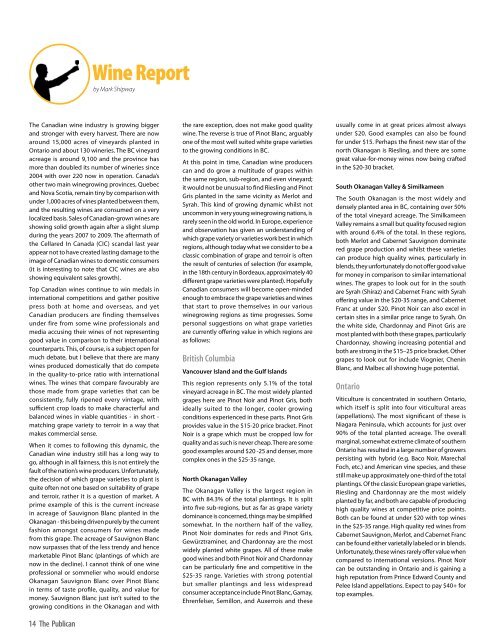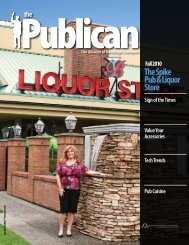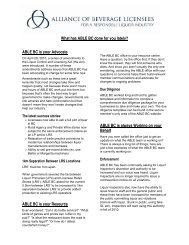Publican - ABLE BC
Publican - ABLE BC
Publican - ABLE BC
- No tags were found...
You also want an ePaper? Increase the reach of your titles
YUMPU automatically turns print PDFs into web optimized ePapers that Google loves.
Wine Reportby Mark ShipwayThe Canadian wine industry is growing biggerand stronger with every harvest. There are nowaround 15,000 acres of vineyards planted inOntario and about 130 wineries. The <strong>BC</strong> vineyardacreage is around 9,100 and the province hasmore than doubled its number of wineries since2004 with over 220 now in operation. Canada’sother two main winegrowing provinces, Quebecand Nova Scotia, remain tiny by comparison withunder 1,000 acres of vines planted between them,and the resulting wines are consumed on a verylocalized basis. Sales of Canadian-grown wines areshowing solid growth again after a slight slumpduring the years 2007 to 2009. The aftermath ofthe Cellared In Canada (CIC) scandal last yearappear not to have created lasting damage to theimage of Canadian wines to domestic consumers(it is interesting to note that CIC wines are alsoshowing equivalent sales growth).Top Canadian wines continue to win medals ininternational competitions and gather positivepress both at home and overseas, and yetCanadian producers are finding themselvesunder fire from some wine professionals andmedia accusing their wines of not representinggood value in comparison to their internationalcounterparts. This, of course, is a subject open formuch debate, but I believe that there are manywines produced domestically that do competein the quality-to-price ratio with internationalwines. The wines that compare favourably arethose made from grape varieties that can beconsistently, fully ripened every vintage, withsufficient crop loads to make characterful andbalanced wines in viable quantities - in short -matching grape variety to terroir in a way thatmakes commercial sense.When it comes to following this dynamic, theCanadian wine industry still has a long way togo, although in all fairness, this is not entirely thefault of the nation’s wine producers. Unfortunately,the decision of which grape varieties to plant isquite often not one based on suitability of grapeand terroir, rather it is a question of market. Aprime example of this is the current increasein acreage of Sauvignon Blanc planted in theOkanagan - this being driven purely by the currentfashion amongst consumers for wines madefrom this grape. The acreage of Sauvignon Blancnow surpasses that of the less trendy and hencemarketable Pinot Blanc (plantings of which arenow in the decline). I cannot think of one wineprofessional or sommelier who would endorseOkanagan Sauvignon Blanc over Pinot Blancin terms of taste profile, quality, and value formoney. Sauvignon Blanc just isn’t suited to thegrowing conditions in the Okanagan and with14 The <strong>Publican</strong>the rare exception, does not make good qualitywine. The reverse is true of Pinot Blanc, arguablyone of the most well suited white grape varietiesto the growing conditions in <strong>BC</strong>.At this point in time, Canadian wine producerscan and do grow a multitude of grapes withinthe same region, sub-region, and even vineyard;it would not be unusual to find Riesling and PinotGris planted in the same vicinity as Merlot andSyrah. This kind of growing dynamic whilst notuncommon in very young winegrowing nations, israrely seen in the old world. In Europe, experienceand observation has given an understanding ofwhich grape variety or varieties work best in whichregions, although today what we consider to be aclassic combination of grape and terroir is oftenthe result of centuries of selection (for example,in the 18th century in Bordeaux, approximately 40different grape varieties were planted). HopefullyCanadian consumers will become open-mindedenough to embrace the grape varieties and winesthat start to prove themselves in our variouswinegrowing regions as time progresses. Somepersonal suggestions on what grape varietiesare currently offering value in which regions areas follows:British ColumbiaVancouver Island and the Gulf IslandsThis region represents only 5.1% of the totalvineyard acreage in <strong>BC</strong>. The most widely plantedgrapes here are Pinot Noir and Pinot Gris, bothideally suited to the longer, cooler growingconditions experienced in these parts. Pinot Grisprovides value in the $15-20 price bracket. PinotNoir is a grape which must be cropped low forquality and as such is never cheap. There are somegood examples around $20 -25 and denser, morecomplex ones in the $25-35 range.North Okanagan ValleyThe Okanagan Valley is the largest region in<strong>BC</strong> with 84.3% of the total plantings. It is splitinto five sub-regions, but as far as grape varietydominance is concerned, things may be simplifiedsomewhat. In the northern half of the valley,Pinot Noir dominates for reds and Pinot Gris,Gewürztraminer, and Chardonnay are the mostwidely planted white grapes. All of these makegood wines and both Pinot Noir and Chardonnaycan be particularly fine and competitive in the$25-35 range. Varieties with strong potentialbut smaller plantings and less widespreadconsumer acceptance include Pinot Blanc, Gamay,Ehrenfelser, Semillon, and Auxerrois and theseusually come in at great prices almost alwaysunder $20. Good examples can also be foundfor under $15. Perhaps the finest new star of thenorth Okanagan is Riesling, and there are somegreat value-for-money wines now being craftedin the $20-30 bracket.South Okanagan Valley & SimilkameenThe South Okanagan is the most widely anddensely planted area in <strong>BC</strong>, containing over 50%of the total vineyard acreage. The SimilkameenValley remains a small but quality focused regionwith around 6.4% of the total. In these regions,both Merlot and Cabernet Sauvignon dominatered grape production and whilst these varietiescan produce high quality wines, particularly inblends, they unfortunately do not offer good valuefor money in comparison to similar internationalwines. The grapes to look out for in the southare Syrah (Shiraz) and Cabernet Franc with Syrahoffering value in the $20-35 range, and CabernetFranc at under $20. Pinot Noir can also excel incertain sites in a similar price range to Syrah. Onthe white side, Chardonnay and Pinot Gris aremost planted with both these grapes, particularlyChardonnay, showing increasing potential andboth are strong in the $15–25 price bracket. Othergrapes to look out for include Viognier, CheninBlanc, and Malbec all showing huge potential.OntarioViticulture is concentrated in southern Ontario,which itself is split into four viticultural areas(appellations). The most significant of these isNiagara Peninsula, which accounts for just over90% of the total planted acreage. The overallmarginal, somewhat extreme climate of southernOntario has resulted in a large number of growerspersisting with hybrid (e.g. Baco Noir, MarechalFoch, etc.) and American vine species, and thesestill make up approximately one-third of the totalplantings. Of the classic European grape varieties,Riesling and Chardonnay are the most widelyplanted by far, and both are capable of producinghigh quality wines at competitive price points.Both can be found at under $20 with top winesin the $25-35 range. High quality red wines fromCabernet Sauvignon, Merlot, and Cabernet Franccan be found either varietally labeled or in blends.Unfortunately, these wines rarely offer value whencompared to international versions. Pinot Noircan be outstanding in Ontario and is gaining ahigh reputation from Prince Edward County andPelee Island appellations. Expect to pay $40+ fortop examples.









